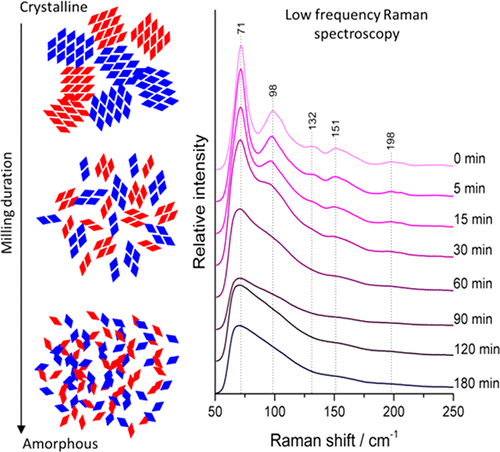当前位置:
X-MOL 学术
›
Mol. Pharmaceutics
›
论文详情
Our official English website, www.x-mol.net, welcomes your
feedback! (Note: you will need to create a separate account there.)
Probing Pharmaceutical Mixtures during Milling: The Potency of Low-Frequency Raman Spectroscopy in Identifying Disorder
Molecular Pharmaceutics ( IF 4.5 ) Pub Date : 2017-11-16 00:00:00 , DOI: 10.1021/acs.molpharmaceut.7b00803 Greg Walker 1 , Philipp Römann 1 , Bettina Poller 1 , Korbinian Löbmann 2 , Holger Grohganz 2 , Jeremy S. Rooney 3 , Gregory S. Huff 3 , Geoffrey P. S. Smith 3 , Thomas Rades 2 , Keith C. Gordon 3 , Clare J. Strachan 4 , Sara J. Fraser-Miller 3
Molecular Pharmaceutics ( IF 4.5 ) Pub Date : 2017-11-16 00:00:00 , DOI: 10.1021/acs.molpharmaceut.7b00803 Greg Walker 1 , Philipp Römann 1 , Bettina Poller 1 , Korbinian Löbmann 2 , Holger Grohganz 2 , Jeremy S. Rooney 3 , Gregory S. Huff 3 , Geoffrey P. S. Smith 3 , Thomas Rades 2 , Keith C. Gordon 3 , Clare J. Strachan 4 , Sara J. Fraser-Miller 3
Affiliation

|
This study uses a multimodal analytical approach to evaluate the rates of (co)amorphization of milled drug and excipient and the effectiveness of different analytical methods in detecting these changes. Indomethacin and tryptophan were the model substances, and the analytical methods included low-frequency Raman spectroscopy (785 nm excitation and capable of measuring both low- (10 to 250 cm–1) and midfrequency (450 to 1800 cm–1) regimes, and a 830 nm system (5 to 250 cm–1)), conventional (200–3000 cm–1) Raman spectroscopy, Fourier transform infrared spectroscopy (FTIR), and X-ray powder diffraction (XRPD). The kinetics of amorphization were found to be faster for the mixture, and indeed, for indomethacin, only partial amorphization occurred (after 360 min of milling). Each technique was capable of identifying the transformations, but some, such as low-frequency Raman spectroscopy and XRPD, provided less ambiguous signatures than the midvibrational frequency techniques (conventional Raman and FTIR). The low-frequency Raman spectra showed intense phonon mode bands for the crystalline and cocrystalline samples that could be used as a sensitive probe of order. Multivariate analysis has been used to further interpret the spectral changes. Overall, this study demonstrates the potential of low-frequency Raman spectroscopy, which has several practical advantages over XRPD, for probing (dis-)order during pharmaceutical processing, showcasing its potential for future development, and implementation as an in-line process monitoring method.
中文翻译:

在研磨过程中探查药物混合物:低频拉曼光谱在识别疾病中的作用
这项研究使用多峰分析方法来评估研磨药物和赋形剂的(共)非晶化速率以及不同分析方法检测这些变化的有效性。吲哚美辛和色氨酸是模型物质,分析方法包括低频拉曼光谱法(785 nm激发,能够测量低频(10至250 cm –1)和中频(450至1800 cm –1)方案,以及830 nm系统(5至250 cm –1),常规(200–3000 cm –1)拉曼光谱,傅里叶变换红外光谱(FTIR)和X射线粉末衍射(XRPD)。发现混合物的非晶化动力学更快,并且确实对于吲哚美辛而言,仅发生部分非晶化(研磨360分钟后)。每种技术都能够识别转换,但是某些技术(例如低频拉曼光谱法和XRPD)比中振动频率技术(传统拉曼和FTIR)提供较少的模糊特征。低频拉曼光谱显示出晶体和共晶样品的强烈声子模带,可以用作有序的灵敏探针。多变量分析已用于进一步解释光谱变化。总体而言,这项研究证明了低频拉曼光谱的潜力,
更新日期:2017-11-17
中文翻译:

在研磨过程中探查药物混合物:低频拉曼光谱在识别疾病中的作用
这项研究使用多峰分析方法来评估研磨药物和赋形剂的(共)非晶化速率以及不同分析方法检测这些变化的有效性。吲哚美辛和色氨酸是模型物质,分析方法包括低频拉曼光谱法(785 nm激发,能够测量低频(10至250 cm –1)和中频(450至1800 cm –1)方案,以及830 nm系统(5至250 cm –1),常规(200–3000 cm –1)拉曼光谱,傅里叶变换红外光谱(FTIR)和X射线粉末衍射(XRPD)。发现混合物的非晶化动力学更快,并且确实对于吲哚美辛而言,仅发生部分非晶化(研磨360分钟后)。每种技术都能够识别转换,但是某些技术(例如低频拉曼光谱法和XRPD)比中振动频率技术(传统拉曼和FTIR)提供较少的模糊特征。低频拉曼光谱显示出晶体和共晶样品的强烈声子模带,可以用作有序的灵敏探针。多变量分析已用于进一步解释光谱变化。总体而言,这项研究证明了低频拉曼光谱的潜力,











































 京公网安备 11010802027423号
京公网安备 11010802027423号